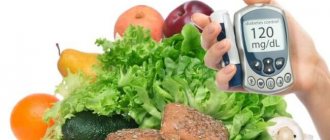Positive properties
The main criterion for the usefulness of cereals is the glycemic index, which shows the amount of sugar entering the body. For type 2 diabetes, it is recommended to consume only those cereals that have a low glycemic level, this will reduce the load on the pancreas and improve absorption of the product. The average figure ranges from 40 to 68 units.
Most cereals for diabetes serve as the main source of carbohydrates; they promote the slow breakdown of glucose, thereby preventing its sudden changes in the body.
A diabetic's diet should include various types of cereals, since they have their own specific characteristics.
Cereals in their chemical composition contain many essential vitamins, microelements, and plant proteins; they are able to replenish the body’s energy reserves and give the patient strength. For diabetics, porridge is the main part of the diet, from which you can prepare delicious dishes and thereby diversify your daily diet. When preparing dishes from cereals, you need to take into account that different methods of culinary processing can both increase and decrease the glycemic index of the product. So, boiling cereals in water is the most acceptable cooking method. To improve the taste of the finished dish, you can add 10 g of cream or 1 tbsp. l. olive oil.
The main factors that determine the usefulness of cereals for diabetes:
- normalize metabolism;
- low calorie content;
- reduce blood cholesterol levels;
- prolonged saturation of the body;
- cleansing the body of toxic substances;
- prevent the development of anemia;
- improves microcirculation in blood vessels.
Cereals for diabetes have a number of advantages, however, if the technology for preparing the product is violated, the dish can become very high in calories, which causes an additional carbohydrate load on the pancreas. This contributes to excess body weight and leads to hyperglycemia, which is a dangerous condition for the patient.
The right food package for diabetics
Meals are organized on the basis of permitted products.
Table of recommended products by category
| Fats | |
| Vegetable | Animals |
| flax seed oil, olive oil, corn oil, sesame oil | no more than 1–1.5 tablespoons of butter |
| Squirrels | |
| Vegetable | Animals |
| mushrooms, nuts | turkey, chicken, rabbit, veal, fish, eggs, seafood |
| Complex carbohydrates | |
| Cereals | Legumes |
| pearl barley, oatmeal, barley, wheat, buckwheat (limited) | beans (preference should be given to green beans), chickpeas, lentils, soybeans |
The choice of vegetables and fruits is determined by the glycemic index
The dairy component of the diet is based on the percentage of fat content of the products. Patients with type 2 diabetes are allowed:
- sour cream and cream – 10%;
- kefir, yogurt, natural yogurt, fermented baked milk – 2.5%;
- cottage cheese – up to 5%;
- acidophilus – 3.2%;
- cheeses – light – 35%, Adyghe – 18%.
Buckwheat
It takes first place among cereals that can be consumed for diabetes, but still you should not get carried away with buckwheat, since it contains up to 60% carbohydrates. However, they are easily digestible and provide constant blood glucose levels for a long time. Diabetics are not recommended to follow a buckwheat mono-diet, since the disease requires a balanced and varied diet.
The rich chemical composition of buckwheat gives it healing properties
Rational consumption of buckwheat will help restore the normal functioning of biochemical processes in the body, due to the rich mineral and vitamin composition of the cereal. It contains a minimal amount of starch and carbohydrates compared to other cereals, and the high content of protein and essential acids can replace meat products for diabetics, which are contraindicated for overweight.
Buckwheat performs the following functions in the body:
- reduces the content of “bad” cholesterol in the blood;
- protects nerve cells from adverse factors;
- promotes a gradual increase in blood sugar levels;
- prevents the development of cardiovascular pathologies.
At the moment, green (unprocessed) buckwheat is considered especially useful. The amount of useful substances in it is several times higher, since it is not subjected to a lengthy process of purification and processing. In addition, green cereals are grown without exposure to pesticides and other chemicals, which allows the beneficial properties of the product to be preserved. Before eating, this variety of buckwheat must first be sprouted. To do this, it is washed under running water, then placed in a container with gauze for 6-7 hours. After time has passed, the grains are washed again and left in the same form. Sprouted buckwheat is stored in a cool place for 3 days.
UZ "Mogilev City Emergency Hospital"
This section is quite complex. However, it is necessary in order to lead a freer lifestyle and achieve diabetes compensation. It will be difficult at first, but then it will become a habit and will be done automatically. We all learned to read syllables, and no one got behind the wheel of a car and immediately drove off.
There are 2 main ways to maintain compensation for diabetes:
1) practically free nutrition (this requires frequent measurements of glycemic levels, accurate counting of carbohydrates in food and the ability to independently adjust the insulin dose);
2) a fixed regimen of insulin therapy (recommendations in hospital discharge notes are based on this approach, and there should be a fixed diet with the same amount of carbohydrates and the same level of physical activity).
In both cases, it is necessary to be able to count food correctly. The first path is more difficult, but it is necessary for young active people. The second way is more suitable for those who lead a measured lifestyle, for example, for older people. With the second way, you can create several menu options and stick to it.
A. Calculation of carbohydrates.
Insulin is necessary for the absorption of carbohydrates.
To compensate for carbohydrates with insulin, you need to clearly determine their amount. Those. For a certain amount of carbohydrates, a certain amount of insulin must be injected. This ratio is individual for each person. If you adhere to a constant insulin therapy regimen and do not change your insulin doses yourself, then you need to constantly consume the same amount of carbohydrates. If you want to adhere to a more liberal diet, you need to be able to count carbohydrates and calculate the dose of insulin for them.
The amount of carbohydrates can be determined in grams or bread units.
The concept of “bread unit” (XU) was introduced for the convenience of calculations. 1 XE = 10-12 grams of carbohydrates. For convenience, it is better to take 1 XE of carbohydrates.
To find out the amount of XE, you need to divide the amount of carbohydrates by 10 (if you count 10 g of carbohydrates in 1 XE).
1 XE on average increases the level by 2-2.8 mmol/l.
For example, 100 g of cookies contains 70 g of carbohydrates, which is 7 XE. If you eat 100 g of cookies, in the absence of insulin in the body, glucose can increase by 14-19 mmol. But these numbers are individual.
So-called diabetic products often contain alcohols as sweeteners (isomalt, sorbitol). They do not increase blood glucose, so the amount of alcohols must be excluded from the total amount of carbohydrates.
For example, 100 g of cookies contains 70 g of carbohydrates, including 20 g of sorbitol. So 70-20=50/10=5 XE.
In the photo above, 100 g of product contains 15 g of carbohydrates (Total Carbohydrate), of which 15 are sugar alcohols (Sugar Alcohol). This product will not increase blood glucose levels.
There is no need to subtract fructose! Fructose increases blood glucose to the same extent as regular sugar.
In the presence of diabetes, 2 problems arise when calculating XE:
- Determine how much XE is contained in this particular product that you are now going to eat (not in 100 g, but in this exact amount of the product that you want to eat, for example, in the porridge that you put on your plate and are going to eat).
- How much food should I eat for the required amount of XE (for example, in the morning I eat 3 XE, but I don’t want porridge, I want potatoes).
In principle, this is 1 task, but from different sides.
- Determination of the amount of XE in a product
The amount of XE can be determined approximately (porridge by spoons, fruit by cups, fruit by the piece), or it can (and should) be more accurately determined by weight.
A rough estimate is taught in many diabetes schools. Why? – Because many patients consider counting with spoons extremely burdensome. But, at least at first, it’s better to weigh your food in order to get used to determining portion sizes by eye. It's not that difficult to install kitchen scales in the kitchen.
How to determine how much XE is contained in a given amount of food by weight:
- find out how many carbohydrates are in 100 g of the product (on the packaging - see the nutritional value of the product - carbohydrates);
- Divide the amount of carbohydrates by 1000 and multiply by the weight of the product (if we count in carbohydrates, then we divide not by 1000, but by 100).
CARBOHYDRATE CONTENT in 100 g x WEIGHT OF FOOD (in grams)/1000
For example, we find on the Internet the nutritional value of potatoes - 17 g of carbohydrates per 100 g. We weigh the potatoes that we want to eat, we get 200 g. 17/1000 * 200 = 2.4 XE (if we count in carbohydrates, then we divide not by 1000, but per 100: 17/100*200 = 24 g carbohydrates).
Vegetables must be weighed before cooking! (During cooking, the weight of the product changes, but the carbohydrates remain.) Approximately, 1 medium potato weighs 60 g, 17/1000*60 = 1 XE. Those. 1 medium potato is approximately 1 XE. But it’s better to weigh the potatoes to get an idea of what 60 g is.
It is correct to weigh dry cereals and pasta, cook and weigh the finished porridge. The amount of XE of dry cereal included in the porridge is divided by the weight of the finished porridge and the amount of XE in your specific porridge is obtained. The porridge may turn out different (in 100 g of viscous porridge there will be less XE than in 100 g of crumbly porridge).
Let's look at buckwheat porridge.
Let's take a cut glass of buckwheat, this is 170 g of dry cereal. In 100 g - 57 g of carbohydrates. 57/1000*170= 9.69 XE. We weighed the finished porridge and got 570 g.
9.69 XE/570*100= 1.7 XE in 100 g of porridge.
If the porridge was cooked in milk, one must take into account the carbohydrates contained in the milk. For example, instead of water, 300 ml of milk was added to the above porridge (100 ml - 0.47 XE, 300 - 1.41 XE). 9.69+1.41=11 XE/570*100=1.9 XE in 100 g of porridge.
Pancakes, pies, etc. are baked in the same way. The amount of XE of all products included in the pie (sugar, flour, milk) is counted. Weigh the whole pie. The amount of XE dry products is divided by the weight of the pie, the amount of XE in 1 gram is obtained, multiplied by 100 - per 100 g.
It's worth doing this at least a few times. Then you will be convinced that a small piece of pie will carry 6-7 XE.
- Calculation of the amount of product for the required amount of XE.
To do this, you need to divide 1000 by the amount of carbohydrates per 100 g or 100 divided by the amount of XE per 100 g.
For example, in 100 g of porridge there are 17 g of carbohydrates, 1000/17 = 58 g of porridge per 1 XE.
In the future, such calculations will not be necessary. It’s convenient to develop XE tables for your menu and put them in the kitchen until the calculations become automatic. You can take Rustem's table as a basis.
How much XE should you eat per day?
| Normal body weight Hard physical labor 25-30 XE Moderate physical labor 20-22 “Sedentary” work 16-18 Sedentary lifestyle 12-15 | Overweight or obesity Hard physical labor 20-25 XE Moderate physical labor 15-17 "Sedentary" work 11-16 Sedentary lifestyle - at least 10 |
Body weight deficiency – 25-30 XE per day. Within each category, men use toward the upper end of the range, and women toward the lower end.
It is not recommended to consume more than 7 XE per main meal.
How can you make your life easier? At first, write down your results. We cooked porridge and wrote it down.
| Food | Carbohydrates per 100 g | Weight per 1 XE |
| Hercules porridge (80 g flakes, 500 milk) | 14,5 | 70 |
| Hercules porridge (100 g flakes, 500 milk) | 15,7 | 64 |
| Hercules porridge (80 g flakes, 500 water) | 9,2 | 109 |
Such a sign can be made for all products and hung on the refrigerator. In the future, everything will work out automatically.
At first, you need to keep some formulas on hand:
- Calculation of carbohydrate content in 100 grams of product (if we prepare food from several ingredients containing carbohydrates)
The amount of all carbohydrates that the product contains/total weight of the product*100
- Calculation of XE in the product
CARBOHYDRATE CONTENT in 100 g x WEIGHT OF FOOD (in grams)/1000
- Calculation of the amount of product for the required amount of XE.
1000/ amount of carbohydrates per 100 g.
B. Glycemic index
Foods with different glycemic indexes have different effects on blood sugar over time (whether they raise glucose levels quickly or slowly). The higher the glycemic index, the faster your blood glucose will increase (such foods should be excluded from the diet, but they are good to eat during hypoglycemia).
Fatty foods increase glucose more slowly because fats inhibit the absorption of carbohydrates (fried potatoes will increase glucose less than mashed potatoes; but mashed potatoes can be slowed down with oil).
Liquid foods (especially warm foods) will increase blood glucose faster.
The absorption rate is also affected by:
- degree of processing of the product (the finer, the faster);
- speed of food intake;
- food temperature;
- Is food washed down?
The glycemic index also needs to be taken into account in order to know which foods are best to eat at what time of day. To avoid high blood glucose levels, the action profile of dietary insulin must match the absorption profile of carbohydrates from food. For example, if carbohydrates are absorbed before insulin begins to act, we will get high glucose levels. If later, we can get hypoglycemia.
Depending on the time, insulin acts differently in the body. In the morning, insulin unfolds slowly; to avoid a high food peak, it is necessary to eat foods with a low GI. At lunchtime, insulin works faster - here it is important to combine foods with high and low GI. In the evening, insulin works fastest - foods with a higher GI are suitable.
Approximate list of products depending on meals
| Breakfast | Buckwheat, oatmeal (not Hercules!), barley porridge, pancakes, dumplings, croutons, omelet, potato pancakes, zucchini pancakes, pasta, cottage cheese. |
| Dinner | Soup, buckwheat, rice, pilaf, boiled, fried potatoes, mashed potatoes, dumplings, potato babka, cabbage rolls, pasta, beans, bread. Vegetable salads will help slow down the absorption of food; they can regulate the pause and/or high blood sugar before meals. |
| Dinner | Rice, boiled potatoes, mashed potatoes, cabbage rolls, millet, corn porridge. Protein – up to 100 grams, so as not to take it into account when selecting the insulin dose |
| Snacks | Fruits, cookies, yoghurts. |
If you use ultra-short insulin analogues, then fruits should be included in the main meal (possibly with a short pause after the main meal).
B. Meal frequency.
Depends on the type of insulin. With genetically engineered insulins (monoinsulin, actrapid, humulin, gensulin), snacks are usually necessary at the peak of insulin action, i.e. usually 2 hours after injection).
On analogues (apidra, novorapid), snacks are not needed.
Is it possible to eat extra food when you want and inject extra insulin on it? In principle, it’s possible, but it’s better not to do this until you learn how to compensate, because profiles of different doses will be layered on top of each other. Before this, it is better not to administer a new dose until the previous dose of insulin has been completed (for genetically engineered insulins - 5 hours, for analogues - 4 hours).
D. Pause between insulin administration and food intake.
In addition to the GI of foods, the exposure time between the injection of short-acting insulin and food intake (pause) plays a huge role. Selected individually. The longest break is usually for breakfast. Insulin analogues are administered without a pause or after meals.
More details about the pause are written in the section “Selection of doses of short-term insulin”.
D. Protein-fat units
Proteins and fats do not contain carbohydrates, but after consuming them, carbohydrates (glucose) are produced through biochemical reactions already inside the body and blood glucose can increase. The effect of proteins and fats on blood glucose is very individual and differs from person to person. For some they increase blood glucose, for others they do not. This can only be determined experimentally by measuring glucose after various meals. Very roughly, 100 g of proteins can be equated to one XE.
In any case, the effect of proteins on SC will be much lower than the effect of carbohydrates. At the same time, proteins and fats increase blood glucose slowly and begin to “climb out” after a few hours.
To determine how proteins affect your blood glucose levels, you need to measure your blood glucose 3-4 hours after eating a protein meal (for example, if you ate a lot of meat without carbohydrates, measure your blood glucose level 3-4 hours later).
Corn grits
The second type of cereal approved by endocrinologists for diabetes, which helps normalize glucose and cholesterol in the body. Corn porridge contains fiber, which improves digestion and cleanses the intestines of toxic substances. The low calorie content of corn dishes helps the patient lose weight, but only if consumed rationally.
Regular consumption of corn grits helps prevent cardiovascular diseases
Corn grits for diabetics are a source of a number of useful substances. It contains:
- vitamins of group B, E, PP, A;
- amino acids (tryptophan, lysine, leucine);
- microelements (silicon, magnesium, phosphorus, zinc);
- alimentary fiber.
Corn-based dishes have excellent taste and will help diversify the diet of a diabetic patient.
Foods that are allowed and prohibited during the diet
You can provide a specific diet for endocrine disease on the ninth table in the context of a 7-day plan. Since there are an extremely large number of recipes for dishes that satisfy this principle of nutrition.
First of all, you need to rely on which food products are allowed, which are partially allowed, and which are strictly prohibited.
The 9th table allows eating:
- vegetable soup with low-fat broth;
- soup with mushrooms or fish;
- chicken, low-fat beef, veal, rabbit;
- low-fat fish, shrimp;
- low-fat dairy products;
- porridge from buckwheat, pearl barley, oatmeal, barley;
- vegetables, with the exception of potatoes, raw or stewed, boiled, baked;
- fruits/berries are not sweet;
- teas, coffee (do not add sugar);
- juices from vegetables, drinks from herbs, such as rose hips.
Conditionally permitted products that comply with the nutritional principle are:
- chicken eggs (2 whole for 7 days, egg whites are allowed to be eaten in larger quantities - up to one and a half per day);
- bran bread made from second grade rye/wheat flour;
- potato;
- honey (uncommon).
Strictly prohibited:
- fatty meat and broths based on it;
- any products made from butter or puff pastry;
- pasta;
- sweet and salty milk-based dishes;
- white rice, semolina;
- legumes;
- marinades and pickles;
- jam and sweet fruits (eg bananas);
- soda and alcoholic drinks.
Prohibited Products
Table 9 is designed in such a way that the chemical composition of the dishes is balanced and includes all the nutrients necessary for the normal functioning of the body.
To maintain liver health, table 9 involves consuming foods high in lipotropic substances, that is, stimulating the breakdown of fats.
To stabilize lipid metabolism, the menu must include vegetable fats.
Oats
Oatmeal is a dietary product that can saturate the body for a long time. It is recommended to eat it as porridge for breakfast with the addition of dried fruits. If you have diabetes, you should give preference to regular cereals, since the flakes are processed, which increases their glycemic index and reduces the amount of nutrients.
Whole oat grains contain a maximum of vitamins, microelements and dietary fiber
Oats contain the following beneficial substances:
- antioxidants (ascorbic acid, tocopherol, flavonoids, provitamins);
- microelements (zinc, phosphorus, magnesium, iron);
- vegetable fats;
- insulin (polysaccharide).
Wheat groats
Wheat dishes are considered to be the most useful and versatile; they can normalize body weight and strengthen the walls of blood vessels.
After eating wheat porridge, sugar levels in the body decrease
Wheat has the following properties:
- the level of triglycerides in the blood decreases;
- reduces blood pressure;
- maintains elasticity and tone of vascular walls;
- speeds up metabolism;
- helps cleanse the body of harmful substances;
- increases the body's defenses.
Wheat germ has pronounced healing properties, since when the grains germinate, the amount of active substances doubles. Sprouted wheat can be added to various dishes, both fresh and dried.
A special variety of wheat cereal serves as the raw material for the production of semolina, however, due to the excess carbohydrate content, it had to be excluded from the diabetic’s diet.
Useful properties and chemical composition
Various types of wheat were the second most common food item in the world in 2021, after corn. Wheat area totaled 220 million hectares worldwide. The average yield worldwide is 34.0 dt/ha. On average, 2 dt/ha of seeds are used.
Cereal is a staple food for people in many countries and is of great importance for animal fattening. Durum wheat is particularly suitable for pasta production, but is practically not grown in Germany.
Regular wheat can be grown as a winter or summer cereal. The plant grows from 40 to 100 centimeters in height. In rare cases, however, the grass can grow to a height of one and a half meters. Wheat prefers warm and relatively dry climates. Although it can be grown in cooler, wetter areas, it does not produce as good a yield. The plant was one of the first cereals cultivated by people. Historical finds indicate that the plant was cultivated about 9,000 years ago. The center of former cultivation was probably in Iran, Iraq, Syria and Saudi Arabia. Around 5000 BC then wheat came to Europe.
In ancient times, the plant was first cultivated by the Romans. It was not until the 11th century AD that wheat was grown in Central Europe. The largest producers of conventional wheat are China, India and the USA. In Russia, about 26 million tons of ordinary wheat are harvested annually. The collected cereal grains are processed into flour in mills. To do this, the wheat is first ground in what is called a mill. The solid form is mainly processed into pasta.
Wheat cereal contains up to 70% carbohydrates, 12% protein, 2% fat and 12% water. The cereal consists of 2% minerals and about 2% fiber. Cereals contain magnesium, potassium, calcium and phosphorus. In addition, the porridge contains a large amount of B vitamins. Vitamin E is also included. Due to the rather low oil yield, wheat germ oil is one of the expensive oils. Butter contains 19% saturated fat. The vast majority, however, consists of polyunsaturated fatty acids. In addition, this oil contains vitamins A, B, D, E and K.
Vitamin E
Rice
In case of diabetes, preference should be given to the brown variety of cereals; it does not undergo the process of grinding and purification, therefore it retains most of the nutrients, compared to white rice.
The shell of unprocessed rice grain contains the bulk of minerals
Properties of rice:
- strengthens the nervous system;
- cleanses the body of harmful substances;
- normalizes intestinal function;
- helps remove excess fluid from the body.
When composing the diet of a patient with diabetes, it is necessary to consider which cereals can be consumed daily and which should be excluded in order to avoid negative effects on the body.
Adverse reactions
Gluten is able to cross both the intestinal and blood-brain barriers, which has been demonstrated in rodent studies. Modern wheat, which is the most widely used and produces the best bread from a functional point of view, has greater cytotoxic and immunogenic capacity.
Neurogluten is the term used to describe various neurological disorders caused by gluten consumption, that is, those that affect any organ or tissue of the nervous system. Patients may develop serious neurological disorders due to consumption of neurogluten.










